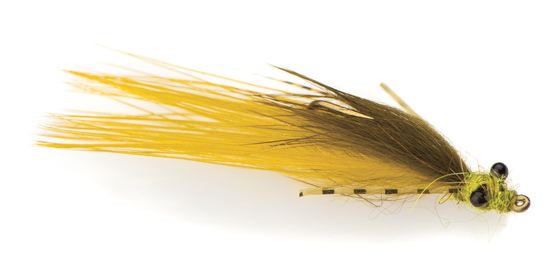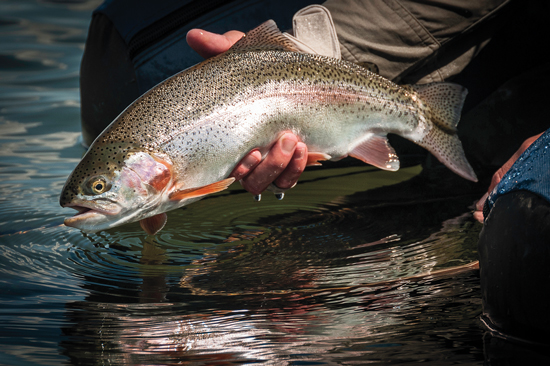June 09, 2016
By Charlie Craven
[caption id="attachment_23297" align="aligncenter" width="550"] Photo | Charlie Craven[/caption]
Photo | Charlie Craven[/caption]
This sexy, slender creation rides hook point up and wiggles when wet
Jay Zimmerman's Ditch Damsel is one of the most creative interpretations I have seen for this ubiquitous stillwater insect. The design elements on the wing and wire body ensure the fly rides hook point up, and the use of dyed mallard flank adds a slight bit of variegation to the pattern.
Damselfly nymphs inhabit lakes, ponds, and slow-moving rivers. They are most active in the late spring and early summer. They emerge on dry land, and as such, their pre-emergence is marked by a mass exodus toward the bank, where the nymphs can crawl out onto a sun-laden stick and dry their exoskeletons before hatching into the wonderful and acrobatic flying blue darts we see in the thrushes. Damselfly nymphs are long, skinny critters with big eyes, and they slide and swim with a seductive side-to-side action as they migrate toward dry ground. Trout, bass, and panfish all have a taste for these slender bites, and when you're in the right place at the right time, the action can be crazy.
Damsel patterns need to be tied slim and sparse, with a bit of weight to keep them swimming shallow and with as much wiggle and shimmy as one can manage. This is a tall order from a fly-designing standpoint. Luckily for me and you, I just happen to work with Jay Zimmerman, one of the most creative fly designers any of us will ever meet.
He and I often take a minute at the shop first thing in the morning to discuss what we tied the night before, or to share theories and ideas on new patterns. It was in one of these little brainstorming sessions that Jay first revealed this pattern to me. It immediately caught my eye, not only from a creative standpoint, but also from Jay's seamless melding and blending of materials to reach an end.
[caption id="attachment_23298" align="alignleft" width="314"] A good damsel imitation is essential on most stillwater fisheries. Trout, bass, and panfish all have a taste for these slender bites, and when you're in the right place at the right time, the action can be crazy. Photo | Charlie Craven[/caption]
A good damsel imitation is essential on most stillwater fisheries. Trout, bass, and panfish all have a taste for these slender bites, and when you're in the right place at the right time, the action can be crazy. Photo | Charlie Craven[/caption]
The Ditch Damsel, as Jay calls his fly, is clearly a product of his wonderfully creative and sometimes scattered brain. His damsel nymph pattern achieves the highly sought-after combination of being truly unique and unconventional while still being perfectly practical and easy to tie. There aren't many patterns that strike me as completely unique these days, and I knew the moment I saw Jay's creation that it was going to be a hit. Every single material on this fly is used and applied in a distinctive and thoughtful way, and they combine to create a wonderful profile and shape. The fact that Jay went so totally out of the box to create it makes it even more appealing to me.
I get so excited about stuff like this at this point in my life and I am not embarrassed to say I really wish I would have come up with this one myself. Tied on a long-shank hook in the inverted position, the fly swims hook point-up and relatively snag-free. The ingenious use of a two-toned wire body to counterweight the hook and achieve this point-up attitude in the water while still being accurately slim and beautiful is one of those things that a fly designer looks at and smacks his head. Though this technique is well used in other tying arenas, applying it to a small and thin damsel nymph is pure brilliance. Jay uses a marabou wing to further help the inversion, as well to give the fly a slinky action in the water. Not leaving well enough alone, Jay also adds a few strands of finely barred dyed mallard or wood duck fibers to the flank of the wings to create a bit of mottling and variegation as well as a heaping teaspoon of class.
Perhaps the most underappreciated and trailblazing technique he used here was stacking a small clump of rabbit fur on the top of the front of the wing. While the fly is dry, this clump just seems to blend into the wing and may leave you wondering why it's even there, but when wet, this clump melds into the wing, creating an ever-so-slightly thicker thorax to accurately mimic the real thing. Finished off with a pair of wriggling Sili Legs and melted mono eyes, this fly is a dead ringer for the real thing and is easily cast, won't foul or snag up, and is completely different than anything we've seen before.
Simple, common materials blended together smartly to create a unique look and a practical fly—man, I love this stuff! The fact that this fly can cross over well and imitate a leech makes it a great searching pattern for both cold and warmwater fish during the warmer months.
Charlie Craven co-owns Charlie's Fly Box in Arvada, Colorado, and is the featured tier in two Fly Fisherman DVDs: Warmwater Fly Tying and Saltwater Fly Tying. His latest book is Tying Nymphs: Essential Flies and Techniques for the Top Patterns, available from Stackpole Books/Headwater Books (2016).
[imo-slideshow gallery=204]

